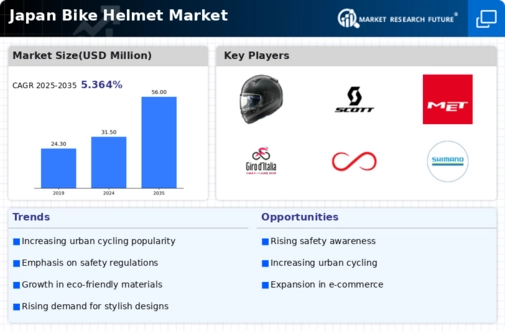Rising Cycling Popularity
The bike helmet market in Japan is experiencing growth due to the rising popularity of cycling as a recreational and commuting activity. Recent surveys indicate that approximately 30% of urban residents engage in cycling regularly, reflecting a cultural shift towards healthier lifestyles and eco-friendly transportation. This trend is further supported by government initiatives aimed at promoting cycling infrastructure, such as dedicated bike lanes and parking facilities. As more individuals take to cycling, the demand for protective gear, particularly helmets, is likely to increase. The market is projected to grow at a CAGR of around 5% over the next five years, driven by this surge in cycling participation. Consequently, manufacturers are focusing on developing innovative and stylish helmet designs to cater to the diverse preferences of cyclists, thereby enhancing the appeal of the bike helmet market.
Government Regulations and Standards
The bike helmet market in Japan is significantly influenced by stringent government regulations and safety standards. The Japanese government mandates that all helmets sold must meet specific safety criteria, which has led to an increase in consumer confidence. As of 2025, compliance with these regulations is crucial for manufacturers, as non-compliance can result in penalties and loss of market access. This regulatory environment encourages innovation and quality improvements within the bike helmet market, as companies strive to meet or exceed these standards. Furthermore, the government actively promotes cycling as a sustainable mode of transport, which indirectly boosts the demand for helmets. The combination of regulatory pressure and consumer awareness creates a robust framework for growth in the bike helmet market, as safety becomes a non-negotiable aspect of cycling culture in Japan.
Increased Focus on Health and Fitness
The bike helmet market in Japan is benefiting from a growing societal emphasis on health and fitness. As awareness of the importance of physical activity rises, more individuals are incorporating cycling into their daily routines. This trend is particularly evident among younger demographics, who are increasingly prioritizing fitness and outdoor activities. According to recent studies, nearly 40% of Japanese adults consider cycling a primary form of exercise. This shift in lifestyle choices is driving demand for high-quality helmets, as consumers become more conscious of safety while engaging in physical activities. Additionally, fitness campaigns and community events promoting cycling are further stimulating interest in the bike helmet market. As a result, manufacturers are likely to see an uptick in sales, as health-conscious consumers seek reliable protective gear to complement their active lifestyles.
Environmental Sustainability Initiatives
The bike helmet market in Japan is increasingly influenced by environmental sustainability initiatives. As the nation strives to reduce carbon emissions and promote eco-friendly transportation, cycling is being positioned as a viable alternative to motor vehicles. This shift is supported by government policies encouraging the use of bicycles, which in turn drives the demand for helmets. Consumers are becoming more environmentally conscious, seeking products that align with their values. Consequently, manufacturers are exploring sustainable materials and production methods to appeal to this growing segment of eco-aware consumers. For instance, helmets made from recycled materials or those that are biodegradable are gaining traction in the market. This focus on sustainability not only enhances the appeal of the bike helmet market but also aligns with broader societal goals of reducing environmental impact, potentially leading to increased sales and market growth.
Technological Innovations in Helmet Design
Technological advancements play a pivotal role in shaping the bike helmet market in Japan. Innovations such as lightweight materials, improved ventilation systems, and enhanced impact resistance are becoming increasingly prevalent. For instance, the introduction of MIPS (Multi-directional Impact Protection System) technology has gained traction among consumers, as it offers superior protection against rotational forces during accidents. As of November 2025, approximately 20% of helmets sold in Japan incorporate such advanced technologies, indicating a shift towards higher safety standards. This trend not only enhances consumer safety but also drives competition among manufacturers to develop cutting-edge products. The integration of smart technology, such as built-in lights and communication systems, is also emerging, appealing to tech-savvy cyclists. Thus, the continuous evolution of helmet design is likely to propel the bike helmet market forward, as consumers seek both safety and functionality.






















Leave a Comment